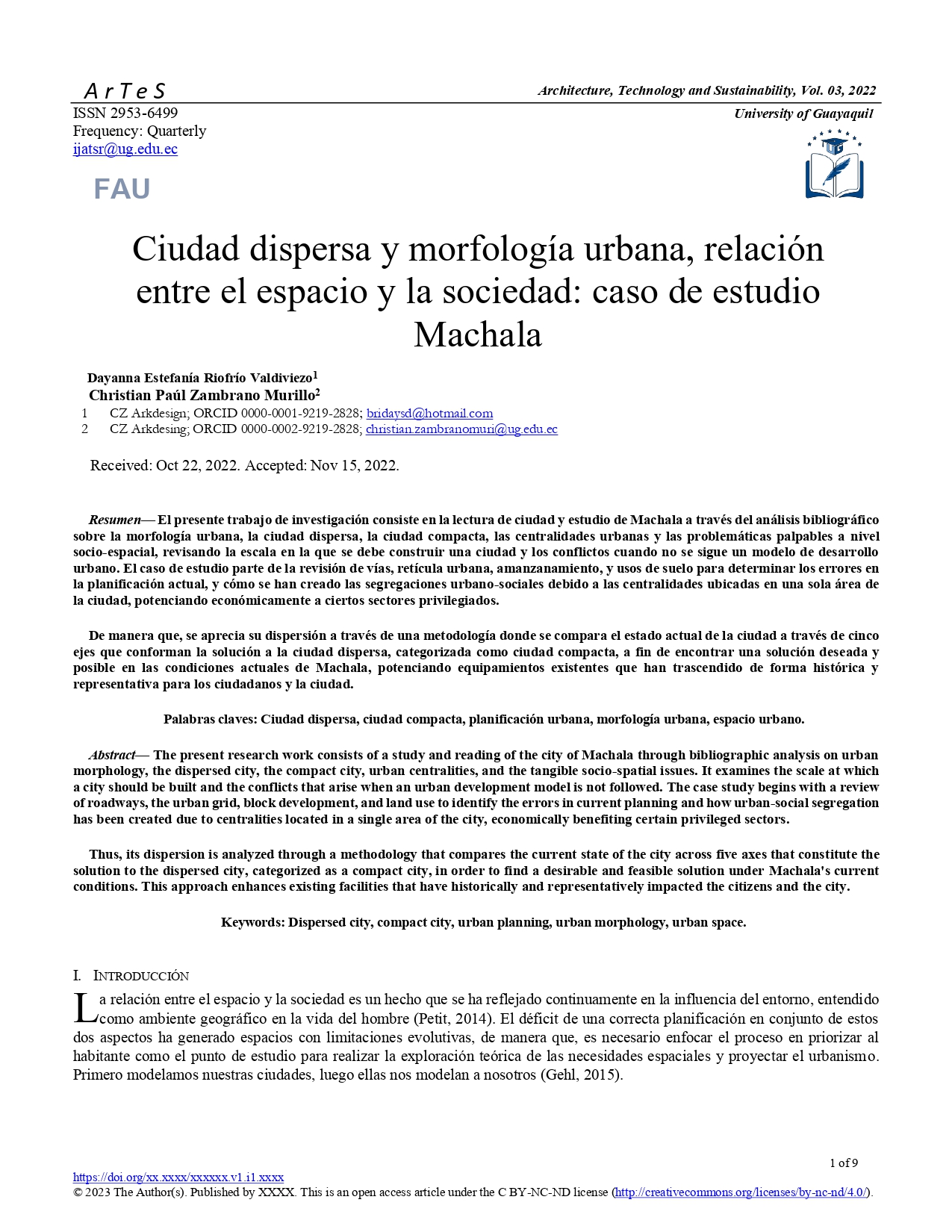Dispersed city, urban morphology, and the relationship between space and society. Case study: Machala.
DOI:
https://doi.org/10.53591/ArTeS.v3.i1.1978Keywords:
Dispersed city, compact city, urban planning, urban morphology, urban space, Dispersed city, Compact city, Urban planning, Urban morphology, Urban spaceAbstract
The present research work consists of the reading of the city and study of Machala through the bibliographic analysis of the urban morphology, the dispersed city, the compact city, the urban centralities, and the palpable problems at the sociospatial level, reviewing the scale at which a city must be built and the conflicts when an urban development model is not followed. The case study starts with the review of roads, urban grid, blockage, and land use to determine the errors in current planning, and how urban-social segregations have been created due to the centralities located in a single part of the city, economically empowering certain privileged sectors. Thus, its dispersion is appreciated through a methodology where the current state of the city is compared through five axes that make up the solution to the dispersed city, categorized as a compact city, to find a desired and possible solution in the current conditions of Machala, enhancing existing facilities that have transcended in a historical and representative way for citizens and the city.
References
G. Tapia, “Lineamientos de Planificación para el desarrollo de un Plan de Infraestructura Verde en la comuna de Algarrobo.”, Santiago. Facultad de Arquitectura y Urbanismo. Maestría en Urbanismo, 2018.
B. Notteboom, "Paisajes residenciales: diseño de jardines, planificación urbana y formación social en Bélgica", Urban For. Urban Green., vol. 30, págs. 220–238, marzo de 2018, doi: 10.1016/j.ufug.2017.02.013.
J. Cuevas, "Plan de movilidad peatonal: reordenamiento de la zona centro de la ciudad de Toluca", 2018. Consultado: 24 de mayo de 2021. [En línea]. Disponible: https://core.ac.uk/download/pdf/161395517.pdf
YP Calderón, “Influencia de los asentamientos informales en los cantones de la provincia de Manabí durante el año 2010-2018 para regular el derecho de propiedad”, 2018, Consultado: 24 de marzo de 2022. [En línea]. Disponible: http://repositorio.ug.edu.ec/handle/redug/34893
R. Tavares-Martínez, JF-O.-R. de Arquitectura, y U. 2019, "Planificación comunitaria en barrios socialmente vulnerables. Identificación de actores sociales en una comunidad", Rev. Arquit., vol. 21, no. 2, pp. 22–32, 2019, doi: 10.14718/RevArq.2019.21.2.2258.
BA Colorado Pástor, MM Fois Lugo, M. Leyva Vázquez y JR Hechavarría Hernández, "Propuesta de un modelo ergonómico tecnológico para personas con discapacidad en el sistema de transporte público de Guayaquil", 2020, pp. doi: 10.1007/978-3-030-19135-1_81.

Downloads
Published
How to Cite
Issue
Section
License
Copyright (c) 2022 Dayanna Estefanía Riofrío Valdiviezo, Christian Paúl Zambrano Murillo

This work is licensed under a Creative Commons Attribution-NonCommercial-NoDerivatives 4.0 International License.



